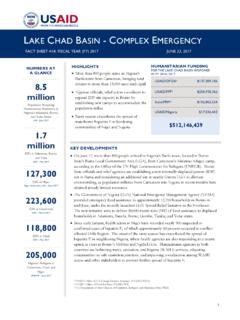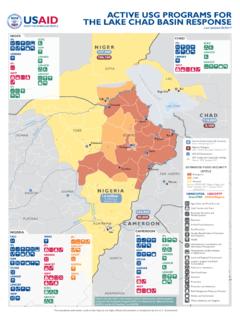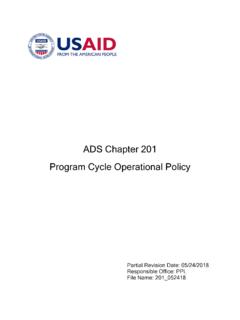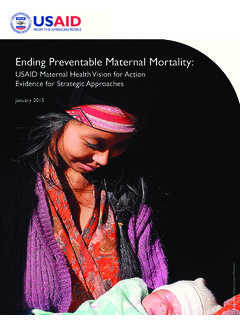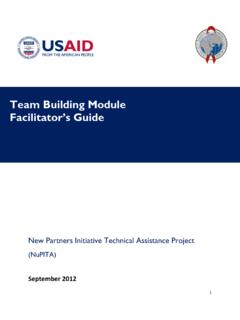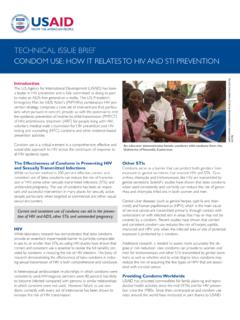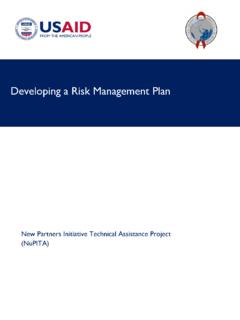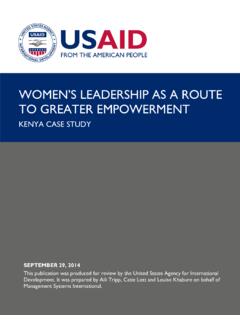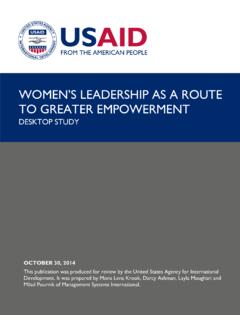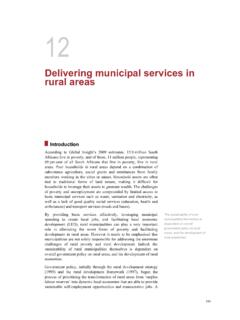Transcription of Scaling up Interventions to Prevent and Respond to GBV
1 I Scaling UP Interventions TO Prevent AND Respond TO GENDER-BASED VIOLENCE AN ANALYTICAL REPORT March 30, 2015 This document was produced for review by the United States Agency for International Development. It was prepared by the Gender, Equity and Social Inclusion Practice of Development and Training Services (dTS), through the Transparency Accountability and Performance (TAP) IQC, Gender-based Violence Strategy Research Agenda Project. USAID s Office of Gender Equality and Female Empowerment has several documents available on addressing GBV through USAID programming that can be accessed through the Development Experience Clearinghouse ( ). USAID Contract Number: AID-OAA-I-10-00014-TO-2-00051 Scaling Up Interventions to Prevent and Respond to GBV: Analytical Report Implemented by: Development & Training Services, Inc. (dTS) 4600 North Fairfax Drive, Suite 402 Arlington, VA 22203 Phone: +1 703-465-9388 ACKNOWLEDGEMENTS This analytical report was funded by United States Agency for International Development (USAID).
2 It was prepared by the Gender, Equity and Social Inclusion Practice at Development and Training Services, Inc. (dTS), and Piotr Pawlak and Neena Sachdeva, Independent Gender Consultants, through the Transparency, Accountability and Performance (TAP) IQC, Gender-based Violence Strategy Research Agenda Project. The authors gratefully acknowledge the support and input from USAID staff members working on selected sectors in Washington, DC, and USAID Mission and State Department staff in India and South Africa. They would also like to thank the staff of non-governmental organizations (NGOs) who participated in consultations and interviews. In particular, they extend their gratitude to: South Africa: Sonke Gender Justice Network in Cape Town, the Soul City Institute for Health and Development Communication in Johannesburg, Medical Research Council of South Africa in Pretoria, University of Witwatersrand in Johannesburg, IMAGE in Johannesburg, the Small Enterprise Foundation (SEF) in Tzaneen, and the Khayelitsha Thuthuzela Care Center in Cape Town; India: International Center for Research on Women in New Delhi, Tata Institute for Social Sciences in Mumbai, Committee of Resource Organizations for Literacy in Mumbai, International Justice Mission in Kolkata and Mumbai, Sanlaap, Mahima and Sari Bari in Kolkata, the United Nations Entity for Gender Equality and the Empowerment of Women (UN WOMEN) in Mumbai; and United Kingdom: London School of Hygiene and Tropical Medicine.
3 They also wish to thank Misrak Brhane from USAID in Washington, , for her critical guidance and essential feedback on the development process of this report, and her technical and administrative support to Dawn Traut, Ashley Mills, Alex Ginn, Payal Chandiramani and Corey Nelson from Development and Training Services, Inc. Finally, the authors would like to express profound gratitude to all program participants, including the women, girls, men, and boys involved in GBV Interventions , projects and research endeavors around the world, who graciously shared their personal stories, experiences, successes and challenges with the research team. Scaling UP Interventions TO Prevent AND Respond TO GENDER-BASED VIOLENCE AN ANALYTICAL REPORT DISCLAIMER The authors views expressed in this publication do not necessarily reflect those of the United States Agency for International Development or the United States Government.
4 CONTENTS Acronyms .. i Executive Summary .. 1 Section 1: Introduction .. 4 Purpose of the Analytical Report .. 4 How to Use This Report .. 5 Commitment to Addressing GBV .. 5 Research Methodology .. 6 Phase 1 .. 6 Literature Review .. 6 Phase 2 .. 7 Interviews and Focus Group Discussions (FGDs) .. 7 Site Visits .. 7 Limitations .. 8 Section 2: Scaling up Methods, Best Practices and Challenges .. 11 Scale-Up Methodologies Defined .. 11 Scaling Up through Expansion of scope .. 11 Scaling Up through Replication .. 12 Scaling up through Expanding Geographic Coverage .. 12 Considerations in Scale-Up .. 13 Best Practices in Scaling Up .. 13 Barriers to Scaling Up .. 14 Theory to Practice .. 15 Section 3: Lessons Learned from Scaled-Up GBV Interventions .. 19 Lesson I: Align Interventions with National Commitments to End GBV .. 21 Case Study: The One Man CAN (OMC) Campaign .. 21 Lesson 2: Secure Community Ownership for the GBV Intervention.
5 24 Case Study: Program H to Yaari Dosti .. 25 Lesson 3: Provide Proof of Concept for the GBV Intervention .. 27 Case Study: Intervention with Microfinace for AIDS and Gender Equity .. 29 Lesson 4: Build a GBV Community of Practice .. 32 Case Study: Stepping Stones .. 32 Lesson 5: Integrate GBV into Government Structures and Sectoral Programming .. 34 Case Study: Combatting Commerical Sexual Exploitation (CCSE) .. 35 Case Study: The Thuthuleza Care Centers .. 38 Lesson 6: Design the GBV Intervention with Scale in Mind .. 40 Case Study: Soul City Institute for Health and Development Communication (IHDC) .. 41 Section 4: Key Lessons and Applying Lessons Learned .. 46 Key Findings .. 46 Alternatives to Scaling up .. 46 Assessing and Designing for Scale-Up .. 47 Annex A: GBV Scalability Checklist Tool .. 48 Annex B: Key Stakeholder Guide .. 51 Annex C: Key Stakeholder Interviews .. 52 Annex D: Promundo Program H Replications .. 57 Annex E: Sector Lessons.
6 58 Annex F: Resource Guide .. 62 i ACRONYMS CBO Community Based Organization CCSE Combating Commercial Sexual Exploitation CORO Committee of Resources Organization for Literacy FGM/C Female Genital Mutilation/Cutting GBV Gender-Based Violence GE Gender Equality GEMS Gender Equality Movement in Schools HIV/AIDS Human Immunodeficiency Virus/Acquired Immune Deficiency Syndrome HTP Harmful Traditional Practices IJM International Justice Mission IMAGE Intervention with Microfinance for AIDS and Gender Equity ICRW International Center for Research on Women IPV Intimate Partner Violence LGBTI Lesbian, Gay, Bisexual, Transgender, and Intersex MAMTA Health Institute for Mother and Child MATI MenEngage Africa Training Initiative MFL Micro Finance Loans MOU Memorandum of Understanding MSI Management Systems International Not dated NGO Non-Governmental Organization NNVAW National Network on Violence against Women NPA National Prosecuting Authority OMC One Man Can Campaign OSC One Stop Centers PEP Post-Exposure Prophylaxis PPSA Planned Parenthood of South Africa RADAR Rural Aids and Development Action Research RCT Randomized Control Trial SAG South Africa Government SCIDHC The Soul City Institute for Health and Development Communication SC4 Soul City Series SEF Small Enterprise Foundation SFL Sisters for Life ii SOCA Sexual Offences and Community Affairs SONKE Sonke Gender Justice Network STIs Sexually Transmitted
7 Infections TISS TATA Institute for Social Sciences TCC Thuthuleza Care Center UNFPA United Nations Population Fund USAID United States Agency for International Development USG United States Government VCT Voluntary Counseling and Testing WHO World Health Organization WJEI Women s Justice and Empowerment Initiative 1 EXECUTIVE SUMMARY This report on Scaling up Interventions to Prevent and Respond to GBV was commissioned by the United States Agency for International Development (USAID) as part of its GBV Strategy Research Agenda to identify lessons learned from scaled-up GBV Interventions to inform and to improve its global prevention and response mechanisms. The information presented in this report may be used to assist in the identification of GBV Interventions that are scalable, or in designing GBV Interventions with sound plans to bring them to scale and to maximize impact. Scaling up refers to taking successful projects, programs, or policies and expanding, adapting, and sustaining them in different ways over time for greater development impact.
8 1 While Scaling up is a common goal of international development donors and implementers alike, there is no universally accepted methodology that is employed. The three scale-up methodologies explored in this report are: expansion of scope, replication and expansion of geographic coverage. The objective of this report is to assist USAID staff in identifying and selecting scalable GBV Interventions across four sectors: (1) health, (2) youth and education, (3) democracy and governance, and (4) economic growth . It is a product of a three-pronged research methodology: (1) a literature review, (2) key informant interviews and focus group discussions conducted in Washington, and by telephone, and (3) data collected from site visits on scaled-up GBV Interventions in India and South Africa. Eighteen scaled-up GBV Interventions were analyzed in the literature review, eight Interventions , which varied by sector and type of scale-up were chosen for further in-depth analysis during the site visits.
9 The mixed-method research design was used to develop this analytical report in order to better understand scaled-up activities to address gender-based violence. While best practices in the development context are important to know when considering any scale-up, further field research was needed to refine this knowledge in the context of GBV. The research team conducted field research on eight innovative, evaluated and scaled-up GBV Interventions in the health, youth development and education, democracy and governance, and economic growth sectors. The best practices in Scaling up focused on three key components: program actions, assessing the enabling environment and influencing factors, and ensuring institutional capacity. The following best practice examples were selected to illustrate initiatives that provide evidence of success in contributing to the prevention of GBV: Health: One Man Can Campaign, Soul City, and Stepping Stones in South Africa Youth and Education: Yaari Dosti and Gender Equality Movement in Schools in India Democracy and Governance: South Africa s Thuthuleza Care Centers (TCCs) and the International Justice Mission (IJM) in India economic growth : The Intervention with Microfinance for AIDS and Gender Equity (IMAGE) in South Africa.
10 1. Brookings Institute Scaling Up: A Path to Effective Development (2007) 2 The Interventions were selected based on an extensive literature review and interviews with key stakeholders. Based on findings from the site research and the literature review, the research team extrapolated six key lessons learned for designing scalable GBV Interventions : 1. Align GBV Interventions with government commitments to end GBV; 2. Secure community ownership for the GBV intervention; 3. Provide proof of concept for the GBV intervention; 4. Build a GBV prevention and response community of practice; 5. Integrate GBV prevention and response into government structures and sectoral programs; and 6. Design the GBV Interventions with scale in mind. Conversely, the greatest barriers to scale-up focused in three areas: lack of support, insufficient intervention design, and weak institutional capacity. Examples of these are: Lack of Support o Lack of large-scale, consistent and comprehensive funding sufficient for Scaling ; short funding cycles o Lack of political commitment, in part due to lack of belief by national level policymakers (and international level bodies) that GBV can be prevented or effectively addressed Insufficient Intervention Design o Demonstration model that was successful in one region may not work in other locations o Inappropriate mix of services planned Weak Institutional Capacity o Charismatic, dedicated leadership that was responsible for small-scale success cannot be replicated o Challenges in holding people accountable Finally, the report concludes with a checklist tool to help USAID staff design GBV Interventions for scale and to assess the scalability of GBV Interventions .
